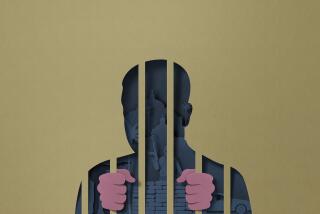Reputed Mexican Mafia Leader Dies in Prison at 64
Joe (Pegleg) Morgan, a Slavic-American street kid from the Eastside who grew up to become the Mexican Mafia’s reputed godfather, has died of cancer while serving a life sentence in state prison, correctional officials said Tuesday.
The 64-year-old convict, whose unlikely ascent through the Chicano gang hierarchy served as inspiration for the movie “American Me,” had spent 40 years behind bars for crimes ranging from murder to a jail escape that he masterminded by hiding hacksaw blades in his prosthetic leg.
In a brutal underworld that usually destroys its kingpins long before they succumb to natural causes, Morgan was a survivor--a shrewd businessman with a paternalistic streak whose ability to control the notorious prison gang impressed even the authorities who worked to lock him up.
“He had his own sense of honor, whether you agreed with it or not, and he lived by it,” said Drug Enforcement Administration agent Joe Moody, a 23-year veteran who headed the state prison gang task force in the mid-1970s. “It would be nothing you’d want to hand down to your children. But in his world, he walked above a lot of people.”
Morgan’s death comes at a critical juncture for the Mexican Mafia, which has brought an uneasy calm to some of Southern California’s most violent barrios by ordering thousands of Latino street gang members to put an end to drive-by shootings or else face the syndicate’s deadly wrath.
It is unclear what role Morgan might have played in enforcing that edict, but law enforcement officials are concerned that his absence could unleash a bloody leadership struggle--one that could also undermine whatever rules of conduct the organization has been able to impose on the chaotic rivalries of the streets.
“Because of his age and the status he carried, Joe could still get people to cool down,” said one correctional official who asked not to be identified. “Now that he’s gone, the setting is right for something to go wrong.”
Known for his shaved head, wooden leg and piercing eyes, Morgan had been housed in the maximum-security wing of Pelican Bay State Prison, where he served his most recent murder conviction alone in an 8-by-10-foot cell for 22 1/2 hours a day. After falling ill, he was transferred to the hospital ward at Corcoran State Prison on Oct. 4.
A series of tests performed Oct. 27 revealed that he had inoperable liver cancer, said his attorney, Shirley J. MacDonald. Morgan’s wife, Jody, with whom he had two children, sought to have him considered for a so-called compassionate release--an option for inmates diagnosed as having less than six months to live. But before the paperwork could even be started, he died Monday morning in his sleep.
“When I visited him about six months ago, he appeared to be losing some weight and his color didn’t look good, but Joe is a very private person and he didn’t complain,” said MacDonald, who is handling a $500,000 lawsuit Morgan filed against Edward James Olmos and the other makers of “American Me” for allegedly basing one of the film’s characters on his life without permission.
It was a sudden end for a man whose criminal career was launched in a sensational fashion.
In 1946, at the age of 16, Morgan became romantically involved with a 32-year-old woman, eventually bludgeoning her 52-year-old husband to death with a tire iron and burying him in a shallow grave in the Malibu hills. While awaiting trial in County Jail, Morgan escaped from custody by posing as his cellmate, who was scheduled to be transferred to a juvenile forestry camp.
After he was recaptured, Morgan was convicted of second-degree murder and sent to San Quentin, where he served nine years. In 1956, a year after his parole, he was sent back to prison for a machine-gun robbery of a West Covina bank, where he made off with $17,000.
While serving his sentence, he was transferred from Folsom back to County Jail in 1961 so he could testify at another murder trial. From there, he led an escape of 11 inmates through a pipe shaft, reportedly using tools hidden in his prothesis. He was arrested a week later as he shopped for groceries on the Westside.
Back in prison, he gradually befriended the leaders of the Mexican Mafia, which was formed at the Deuel Vocational Institution in Tracy in the mid-1950s by a group of hard-core Eastside gang members seeking to establish a “Gang of Gangs.” Although he was Anglo, Morgan was fluent in Spanish and identified strongly with Latino culture.
“As far as we were concerned, he was a Mexican,” said Ramon (Mundo) Mendoza, 43, a former Mexican Mafia hit man, who left the organization in the mid-1970s after embracing Christianity. “If anybody ever called him a ‘white boy,’ I have no doubt he would have killed them. He knew what he was as far as his genes were concerned. But his heart was Chicano.”
Once firmly inside the Mafia--usually known as La Eme, Spanish for the letter M -- Morgan studied ancient Aztec mythology and the writings of Octavio Paz. He got along well with the guards, but never sold out his comrades, often using the affectionate term mi hijo to address a particularly trusted friend.
“With his savvy, his manipulative skills, his intelligence, his charisma and his knack for being profitable, he easily could have been the president of a major corporation,” Mendoza said. “Part of him was cruel and coldblooded. But there was a side of Joe that was very human, very humane.”
Mendoza’s testimony had led to Morgan’s second murder conviction, for arranging the 1977 execution of a suspected Seal Beach drug dealer. Unaware that Mendoza had turned on him, Morgan asked him to pull the deal off, supplying him with a picture of the victim, his house key and a .45-caliber pistol stuffed in a brown paper bag.
“When I heard that Joe died, I felt a small twang of guilt,” Mendoza said. “I didn’t really want to give him up. He had an option of choosing a different path. But he made his commitment and he took it to the grave.”
More to Read
Sign up for Essential California
The most important California stories and recommendations in your inbox every morning.
You may occasionally receive promotional content from the Los Angeles Times.










